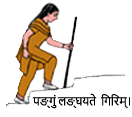 Qualifications:
Qualifications:
B.A.M.& S. - Tilak Ayurveda Mahavidyalaya, University of Pune
M.A.Sc. – Master of Ayurvedic Science (Rognidan, Kayachikitsa, Modern Medicine & Therapeutics)
R.A.Podar Medical College, (Ayur.) Mumbai, University of Pune
Awards and Honours:
- Fellow of Institute of Indian Medicine (1999)
- Ayurveda Varidhi (Doctorate), European Ayurveda Academy(2007)
- Best Ayurveda Research Guide Award (2007), European Ayurveda Academy
- International Ayurveda Bhooshan Award, Deerghayu International (2010)
Teaching Experience:
- R.A.Podar Medical College (Ayur.) Worli, Bombay. (1976-77)
- Tilak Ayurveda Mahavidalaya ,Pune (1985 to 2002)
- Padmashree D.Y.Patil College of Ayurveda, Pimpri, Pune (2002-06)
- Post graduate Teacher, University of Pune (1987-2002), 20 Students.
- Ph.D. Guide, Tialk Maharashtra University (2007 Onwards)
- Guide for Research Members of Institute of Indian Medicine, Pune (1986 Onwards)
Clinical Experience:
- Sane Guruji Rugnalaya , Hadapsar , Pune (1987-91)
- Seth Tarachand Ramnath Hospital , Rasta Peth, Pune (1993-98)
- V.P.Nanal Hospital , Karve Road, Pune (1985-2002)
- Padmashree D Y Patil Ayurveda Hospital, Pimpri, Pune (2003-06)
Academic Activities:
- Member, Board of Studies, Faculty of Ayurveda, University of Pune (1985-88)
- Member, Managing Committee, Tilak Ayurveda Mahavidyalaya, Pune (1990-95)
- Member, Managing Committee, Ayurveda Rasahala, Pune (1985-90)
- Member, Managing Committee, V.P.Nanal Hospital, Pune ( 1985 to 2005)
- Examiner (University of Pune ) – B.A.M.S. and M.D. (Ayurveda) Examinations
- Invited speaker Central Council for Research in Ayurveda and Siddha
- Attended various National & International Seminars & Conferences.
- Lectures in International Ayurveda Conferences
Publications:
- Dhatuparinati Formation of Dhatus
- Amlapitta pathophysiology
- Kapha Physiology Kriyasharir
- Srotas Pareeksha Ayurveda Clinical examination
- Swadu - Aswuta Bhakti Ayurveda Research Methods
- Hyperacidity Ulcer Ayurveda Drugs
- Diarrhoea due to Indigestion Dissertation Final
- Jambu fruit pulp in Diabetes
- Punarnava Boerhavia diffusa in cardiopulmonary anasarca 1987
- Viral Hepatitis Ayurveda Medications Clinical Studies
- Curill Antipyretic
- Concept of Mind in Ayurveda
- Ayurveda Vascular diseases in diabetes Heart disease and aging
- Diabetes Present Knowledge and Ayurveda Classics
- Alcohol and substance abuse_addiction in Ayurveda
- Lead poisoning Nag and Ayurveda compounds
- Osteoporosis vis-a-vis Asthikshaya in Ayurveda
- Rheumatology and Indian Systems of Medicine
General instructions about exercise
Do exercises in fresh, pleasant environment.
It is better to exercise on empty stomach (morning/evening).
Do not eat anything for about an hour after exercise. Sips of water or other fluids are allowed.
Wear comfortable cotton clothes during exercise.
Use proper footwear during exercise. Use of sports or canvas shoes recommended.
Breathe in and out normally from nose. Avoid mouth-breathing.
Concentrate on your exercise and exercise slowly. Never exercise hastily; do not jerk your joints.
Rest for a minute or so if you feel fatigue.
Concentrate on the joint or muscle group for which you are exercising.
Learn exercises, especially those for shoulder, from a physiotherapist.
One should feel relaxation of muscles after exercise. Increase in pain after exercise may indicate wrong method. Stop exercise and meet your physiotherapist again in such situation.
Be relaxed and maintain proper posture during exercise. It is good to look into a mirror during initial days of exercise.
Maintain a posture for about 10 seconds and return back slowly to resting position.
Start low - for some minutes - and increase your work-out gradually.
Exercise one sided limbs at a time initially. Simultaneous exercise for both limbs will be possible after some days.
Exercise twice each day. Regularity is of utmost importance.
Look for a friend if exercising alone gets boring. Exercise accompanied by music is quite entertaining.
Balanced diet is also necessary appropriate benefits of exercise. Meal timings should be strictly adhered to. Consult a dietitian for reducing weight.
General instructions for yoga practice
Yoga postures should be practiced in a clean and fresh surrounding. Do the asanas on a soft and clean mattress. Use clean, light, loose and minimum clothing.
Do the asanas in morning or evening on empty stomach. Eat light food half an hour after completing practice.
Warm-up, in the form of Soorya-namaskar is desirable prior to asanas.
All movements should be gentle and controlled. Do not jerk your body. Do not over-stretch. Do not use any force to overdo.
Watch your breathing. Breathing should be easy and natural. Exhale while you bend forwards and inhale while bending backwards. Never hold breath.
One should be comfortable in any asana. Do whatever little you can. Do not try to overstretch to attain a pose as given in pictures. Trembling during asana implies overdoing.
Steadiness is of utmost importance. Period of staying in a single pose will increase with practice. Try to contract only those muscles that are required for a particular pose while relaxing all other muscles.
Draw your mind away from your body and concentrate on breathing on attaining desired pose.
Select and practice a few asanas and try to master them.
There should not be any pain, fatigue or sweating during asanas. Do a resting asana if any of these appear. One should feel enthusiastic after a yoga session.
45 minutes of yoga practice each day is desirable. Pranayama may also be done for a few minutes. Regularity is the key to success.
